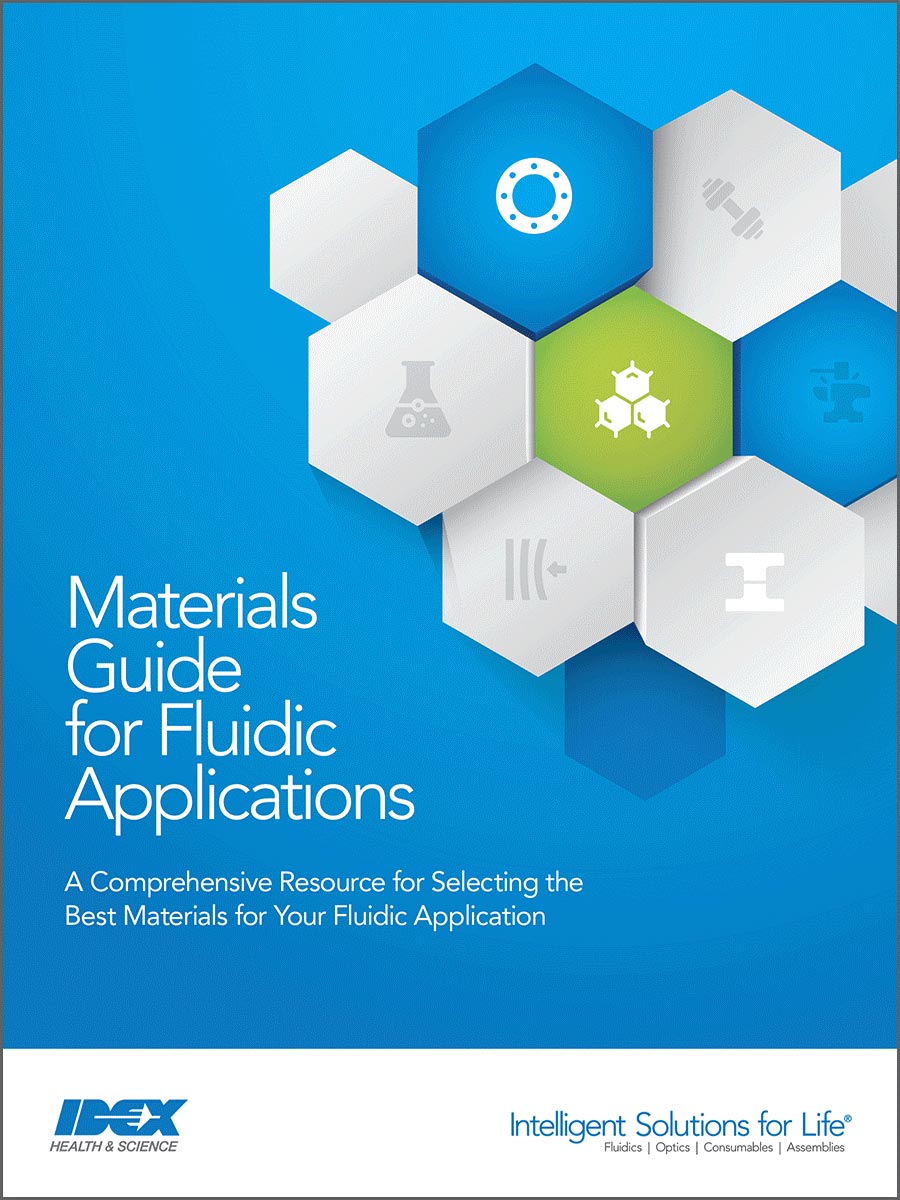

Glossary of Material Terms for Fluidic Applications

When it comes to designing high-performance fluidic systems, material selection isn’t just important — it’s essential. The right material ensures reliability, durability, and precision, even in the most demanding environments. At IDEX Health & Science, we recognize how critical it is to understand the properties and performance of each material used in your application.
That’s why we’ve created a materials glossary as part of our comprehensive Materials Guide—your go-to resource for decoding the terminology behind polymers, metals, elastomers, and more. Whether you're navigating chemical compatibility,
mechanical strength, or thermal stability, our glossary helps you make confident, informed decisions.
Explore the terms and choose with confidence:
Prefer to download our Materials Guide? Access the Guide
316 Stainless Steel: See page 8 of Materials Guide.
Acrylic: See page 9 of Materials Guide.
Arc Resistance: The ability of a material to resist electrical breakdown when exposed to high-voltage electric arcs.
Autoclavable: Indicates whether a material can withstand high temperatures and pressures used in autoclave sterilization processes.
Chemical Family: A group of materials that share similar chemical structures and properties, often impacting their performance in certain applications.
Chemical Resistance: A material’s ability to withstand exposure to aggressive chemicals without degrading.
Coefficient of Thermal Expansion: The rate at which a material expands or contracts when exposed to temperature changes.
Conductivity: A material’s ability to conduct heat (thermal conductivity) or electricity (electrical conductivity).
Corrosion Resistance: A material’s ability to resist degradation caused by moisture, salts, or other corrosive elements.
Delrin® (Polyoxymethylene): See page 10 of Materials Guide.
Dielectric Constant: A measure of a material’s ability to store electrical energy in an electric field.
Dielectric Strength: The maximum electric field a material can withstand without electrical breakdown.
Dissipation Factor: A measure of energy loss in a material when used in electrical applications.
Durability: The ability of a material to perform reliably over time, resisting wear and tear.
ETFE: See page 44 of Materials Guide.
FEP: See page 13 of Materials Guide.
Fittings: Mechanical components used to join tubing, pipes, or other fluidic pathways, ensuring secure and leak-free connections.
Flexibility: The property of a material that allows it to bend or stretch without breaking or losing its shape.
Flexural Modulus: A measure of a material’s stiffness or resistance to bending when a force is applied.
Flexural Yield Strength: The stress at which a material begins to deform permanently under bending conditions.
Halar® (ECTFE): See page 15 of Materials Guide.
Hardness: A material’s ability to resist indentation or scratching, typically measured on scales like Shore or Rockwell.
HPFA and HPFA+: See page 27 of Materials Guide.
Mechanical Properties: Characteristics that define how a material responds to physical forces, including tensile strength, flexural strength, and impact resistance.
Oxygen Permeability: The rate at which oxygen can pass through a material, expressed in standardized units.
PCTFE (PolyChloroTriFluoroEthylene): See page 18 Materials Guide.
PEEK (Polyetheretherketone): See page 20 of Materials Guide.
Perlast®: See page 23 of Material Guide.
pH Range: The range of acidity or alkalinity that a material can tolerate without degradation.
Poisson’s Ratio: A measure of how a material deforms in directions perpendicular to applied stress, describing its ability to contract or expand.
PFA: See page 25 of Materials Guide.
PK (Polyketone): See page 29 of Materials Guide.
Polyethylene: See page 31 of Materials Guide.
Polyoxymethylene (POM or Acetal): See page 33 of Materials Guide.
Polypropylene: See page 34 of Materials Guide.
Polysulfone: See page 36 of Materials Guide.
Polyvinyl Chloride (PVC): See page 40 of Materials Guide.
Porosity: The presence of small voids or pores in a material, which may impact strength, permeability, or chemical resistance.
PPS (Polyphenylene Sulfide): See page 38 of Materials Guide.
Pressure Rating: The maximum pressure a material or component can safely withstand without failing.
Radel® R: See page 41 of Materials Guide.
Sterilization Techniques: Methods for sterilizing materials, including autoclaving (steam), gamma irradiation, and ethylene oxide treatments.
Temperature Stability: A material’s ability to maintain performance across a range of temperatures, including extreme heat or cryogenic conditions.
Thermal Properties: A group of characteristics, including thermal conductivity, expansion, and resistance, that define how materials respond to heat.
Titanium: See page 46 of Materials Guide.
TPX® (Polymethylpentene): See page 48 of Materials Guide.
Transparency: The optical clarity of a material, which is critical for applications requiring visibility or light transmission.
Tubing: Hollow components designed to transport fluids or gases, often chosen based on material properties like chemical resistance and flexibility.
UHMWPE (Ultra High Molecular Weight Polyethylene): See page 51 of Materials Guide.
Ultem®: See page 53 of Materials Guide.
UV Stability: The ability of a material to resist degradation when exposed to ultraviolet light.
Vespel®: See page 56 of Materials Guide.
Viscosity: A measure of a fluid’s resistance to flow, which can impact fluid handling and system performance.
Water Absorption: The measure of how much water a material can absorb over time, typically expressed as a percentage of its weight.
Wear Resistance: The ability of a material to resist damage caused by friction or abrasion.
Yield Strength: The stress at which a material begins to deform permanently.Download the Full Version of Our Materials Guide

